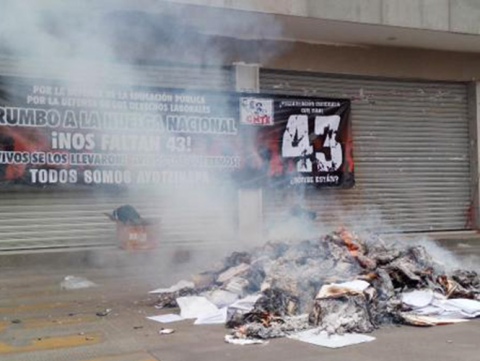Midterm elections were held in Mexico with an abstention rate of over 55%. Election day was diverse and contradictory. We saw a struggle for an open boycott in states like Oaxaca, Guerrero, Chiapas and Michoacan. An independent candidate in Nuevo Leon won. As well, different expressions of local discontent were revealed as the advance of Morena in Mexico City and the retreat of the PRD, which has ruled the capital since 1997, has shown. The general characteristic of this election is that it reflects a growing criticism of the regime and the need for change. Contrary to official statements, what we saw was not the strengthening of democracy, but rather an increased questioning of all political parties and the outdated and corrupt state institutions.
Lorenzo Cordova, executive president of the National Electoral Institute (INE), said that the election was positive, as 99.84% of the polling booths were installed. With this they want to show that the boycott failed and "democracy won". They want to to give the impression that the "radical" National Coordination of Education Workers (CNTE) union, which was the main driving force behind the boycott, was defeated. In reality, they only managed to carry out the elections through the militarisation of whole regions. An election where you have to resort to such mobilisation of state forces reflects the discredited nature of the system. This system cannot use only mere demagoguery, but must resort to open repression, including the imprisonment of dozens of pro-boycott teachers and demonstrators.
In the run up to the elections 16 candidates and a total of 21 politicians were killed. In several regions, it was the drug cartels who decided the candidates and their programmes. Almost all parties received threats. Violence prevented some of them from standing candidates in several cities.
One of the most serious cases of violence took place in Veracruz, a state which has been hit hard by organized crime. Amid this atmosphere of rejection of the elections, on June 1, National Electoral Institute (INE) facilities in Veracruz, Oaxaca and Puebla were attacked with firebombs. Emails circulated blaming students of the Universidad Veracruzana for the attack. On June 5 a commando of a dozen men armed with bats, sticks with nails sticking out and machetes, attacked a group of young people at a party. The attack was carried out with great brutality, sending a clear signal. The comrades who suffered the attack were members of an environmental group and had been involved in the struggle for justice for Ayotzinapa. Eight youth were injured with multiple wounds all over their body, two of them had a dislocated jaw and pulled teeth, another one suffered severe head injuries. This was an act of pure terror.
The boycott
The disappearance of 43 students of the Ayotzinapa teacher college in September remains unresolved. Parents of missing students said that if their children did not appear there would be no elections. The CNTE teachers' union agreed to promote the boycott of the elections, although from the outset it was clear that it was not possible to enforce it nationally and that the boycott would be limited to certain states. Peña Nieto's government tried to negotiate the teachers' demands with the CNTE so that the boycott would be called off, but failed. One of the problems regarding the boycott tactic was that the movement of teachers and community police in Guerrero was unified as a whole under this idea, which already limited its scope. Meanwhile, in Oaxaca, the CNTE carried out the boycott on its own, without offering a united front to the other workers', student, and popular organisations. All of these factors limited the scope of the election boycott.
The election boycott could not be tolerated by the regime as it challenges one of the pillars of bourgeois democracy, which is nothing else but the dictatorship of big capital against the majority of working people. In Oaxaca, the CNTE took over INE facilities in 11 district and destroyed electoral material a few days before the elections. There were other actions such as the occupation of Oaxaca airport. The state reacted and the army was sent in to take back control over INE facilities. There was a huge mobilization of repressive state bodies, such as the Federal Police, the Army and Navy. In the Mixteca region, a popular uprising fought back against the repressive forces. In Huajuapan de Leon, the Federal Police arrested four activists and the masses responded by capturing the police. In the end there were 30 wounded on both sides. There are videos showing how the army was forced to retreat by the masses (see: https://www.youtube.com/watch?v=qp8Vt_sHYO8). In Tlaxiaco, also in the Mixteca region, protesting teachers pushed back and surrounded the police. In Teotitlán, defensive barricades were erected to defend protesters prior to the arrival of the forces of repression. INE facilities in several districts were burnt down. In the end the army was able to regain control of most of the district offices, but clashes continued.
The revolt against the elections in Oaxaca resulted in 283 booths being burnt down, 56 of which were not installed, 75 which were disabled, 92 detainees (who are being sent to maximum security prisons) and one dead (proceso.com.mx). Abstention in this state was over 60%. In Chiapas 15 booths were not installed and 29 were cancelled on election day. In Guerrero 26 booths were not installed. In total there were 603 booths which could not be used. Although the authorities try to minimize this fact, it is the highest figure since the IFE-INE has existed, nearly 4 times the last record. (La Jornada 8 / 06/15).
Communities in the Purépecha Plateau in Michoacan also suspended the elections, as was the case in Oruscato, Cherato, Cheratillo, March 18, Pichátaro and Urapicho. These communities were following the example of Cherán - a community that has organised its own armed self-defence since 2011 against drug traffickers linked to illegal logging, which has already suspended elections twice and elected their representatives through direct democracy. In other communities in the region where elections were held, villagers said they would give their vote to Hipólito Mora, the head of the armed self-defense group (lajornadamichoacan.com.mx).
Meanwhile, on June 5, in Tlapa de Comonfort, Guerrero, there were demonstrations involving thousands of farmers, teachers and villagers. Protesters captured police officers while the state forces used repression to enter the CETEG teachers' union offices and arrested Juan Sanchez, Pablo Abad, Angel Basurto, Francisco Ortega, Julian Allende, Raul Sierra, Herlinda Iturbide, Juan Hernandez and Agustin Moon. The police, acting in unison with a group of PRI thugs known as Los Cholos, attacked members of the Buerrero Popular Movement and one of its leaders, Juan Sanches, who was stabbed in the back (La Jornada 06/06/15). Before the elections, to prevent the boycott, the repressive state forces carried out a razzia in colonies of this municipality. Without any arrest warrants, about 50 Federal Police raided a house and captured MPG leaders, including Professor Juan Sanchez Gaspar (proceso.com.mx). Peña Nieto broadcasted a message to the nation on the evening of June 7, saying that democracy was advancing, that "citizens had rejected the violence of those who tried to prevent the election", and that the institutions had been "strengthened". Nothing is further from the truth. It was only with brutal state violence and PRI shock groups that this "festival of democracy" took place.
In Tixtla, 8 kilometers from Ayotzinapa and where several of the 43 missing teacher students come from, the State failed to install more than half of the polling stations, in addition to widespread burning of ballots. The boycott here was so strong that at noon the elections were officially annulled. Later on, the State rectified so as not to give official recognition to the victory of the boycott. Recognizing that the elections had been cancelled in Tixtla would have been a national example.(see https://www.youtube.com/watch?v=s9hzpfbq2UI)
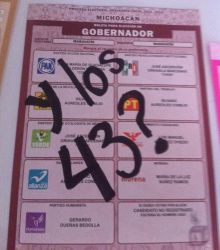 The mass movement, which late last year had the government of Peña Nieto on the ropes, has simmered out. This is the most important factor that has limited the electoral boycott. On the other hand we see that, in the case of Guerrero, there was a split within the CETEG teachers' union and the Community Police on the issue of boycott or participation in the elections. This allowed the repressive state to carry out the election. In the end, in Guerrero and Oaxaca, the PRI will win the election but will be faced with a mass movement of opposition. This is a finished recipe for future clashes between the classes.
The mass movement, which late last year had the government of Peña Nieto on the ropes, has simmered out. This is the most important factor that has limited the electoral boycott. On the other hand we see that, in the case of Guerrero, there was a split within the CETEG teachers' union and the Community Police on the issue of boycott or participation in the elections. This allowed the repressive state to carry out the election. In the end, in Guerrero and Oaxaca, the PRI will win the election but will be faced with a mass movement of opposition. This is a finished recipe for future clashes between the classes.
These elections, far from reflecting a strengthening of governmental institutions, show a growing questioning of the State and it’s illegitimate repressions. This rejection was also shown across the country with thousands of ballots which were voided by writing messages against political parties or for the appearance of the 43 students. There were more than 1.5 million nullified votes.
The election result
The PRI is one of the main instigators of the country's poverty, and ironically takes advantage from this situation through buying votes with food parcels, social programs, money, etc. The State handed out 100,000 flat screen TVs in recent weeks. These classic methods of the PRI allowed them to win the elections again, followed by the PAN.
According to the INE, in its third and final count, the PRI obtained between 29.83 and 30.85% of the vote and between 105 and 116 deputies. The PAN received 21.47 to 22.2% of the vote and between 105-116 deputies. The PRD collapsed and will get between 11.14 and 11.81% of the vote and between 51 and 60 deputies. The left wing Morena which stood for the first time will get 8.8 to 9.15% and 34 to 40 deputies. The Green Party which carried out a scandalous campaign violation will have between 7.15 and 7.55% of the vote and 41 - 48 MPs. The Citizens Movement will receive 6.31 to 7.43%. New Partnership will receive 3.88-4.14% and 9-12 deputies. The Social Gathering, which campaigned against the traditional politicians, will keep its electoral registration with 3.4-3.61% and 8 to 10 seats, while the Humanists Party (0-1 seat) and the Party of Labour (3-12 deputies) have difficulties in achieving the necessary votes to maintain their registration. The PT while presenting itself as a genuine left party, is not seen in practice as an alternative to Morena, and made all sorts of opportunistic alliances at a local level with parties like the PRD, PAN and PRI.
The PRI will remain the leading political force and with its faithful ally, the Greens, will have a majority in parliament. The PRI will win most of the governorships that were contested, followed by the PAN, and the PRD will govern Michoacan.
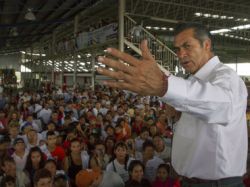 A prominent case is that of Nuevo Leon, in the northeast, which contains the country's second largest city. The situation in this state has become very bad in recent years, plagued by violence and growing poverty. Here, an independent candidate has defeated the bipartisanship of the PRI and the PAN. José Rodríguez Calderón, popularly known as Bronco, has swept the vote getting about 45%. His campaign rallies have attracted a lot of people who also went to the Macro Plaza Monterrey and to the streets to enthusiastically celebrate the victory. This fact shows, in a distorted way, the aspirations for change of the population of Monterrey.
A prominent case is that of Nuevo Leon, in the northeast, which contains the country's second largest city. The situation in this state has become very bad in recent years, plagued by violence and growing poverty. Here, an independent candidate has defeated the bipartisanship of the PRI and the PAN. José Rodríguez Calderón, popularly known as Bronco, has swept the vote getting about 45%. His campaign rallies have attracted a lot of people who also went to the Macro Plaza Monterrey and to the streets to enthusiastically celebrate the victory. This fact shows, in a distorted way, the aspirations for change of the population of Monterrey.
The Bronco is a businessman who campaigned for more than three decades as part of the PRI, broke with the party in 2014, and has now stood as an independent candidate. With a hard hitting and down to earth language, the Bronco was mayor of the municipality of Garcia where he became known for cleansing the police forces of criminal elements. The region is known to have been infiltrated by the drug cartels. Despite this, he has fought against organized crime and has suffered two attempts on his life.
The development of consciousness occurs unevenly in the country, and the desire for change was also expressed electorally in Mexico City, through the boycott in the southeast, and in Nuevo Leon, which is not the state with the most advanced class consciousness. The rejection of the PRI and the PAN was expressed with the victory of a candidate with whom people identify. Of course, we have no confidence in this political demagogue. However these elections show that things are beginning to change in this state. The experience of events will help develop the consciousness of working people, who will look for clearer ways of putting an end to the evils which are rooted in the decadent nature of Mexican capitalism.
Morena and PRD
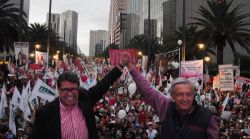 Morena, the left party led by Lopez Obrador, is practically the only real opposition party in the country. Morena has opposed every counter-reform proposed by president Peña Nieto. The setting up of Morena was the conclusion of years of rich struggle of the Mexican people, including the movement against fraud in 2006 and the defense of the state oil company. These are the first elections in which it is has stood. Morena has positioned itself as the fourth largest party followed closely by smaller parties like the Citizens Movement and the right wing Green Party. On the other hand the PRD is in a process of decay. Corruption and loss of support will continue in the following years. These elections reflected the fact that Morena does not have sufficient authority in the eyes of the masses. There is a certain degree of scepticism among its own voters and even open opposition amongst some groups of workers. These workers do not see Morena as having adopted the approach needed to carry out fundamental change.
Morena, the left party led by Lopez Obrador, is practically the only real opposition party in the country. Morena has opposed every counter-reform proposed by president Peña Nieto. The setting up of Morena was the conclusion of years of rich struggle of the Mexican people, including the movement against fraud in 2006 and the defense of the state oil company. These are the first elections in which it is has stood. Morena has positioned itself as the fourth largest party followed closely by smaller parties like the Citizens Movement and the right wing Green Party. On the other hand the PRD is in a process of decay. Corruption and loss of support will continue in the following years. These elections reflected the fact that Morena does not have sufficient authority in the eyes of the masses. There is a certain degree of scepticism among its own voters and even open opposition amongst some groups of workers. These workers do not see Morena as having adopted the approach needed to carry out fundamental change.
The founding congress of Morena stated that the organization was not just a party, but a movement. The congress declared that elections were just one amongst many methods of struggle. In practice, Morena has adopted a purely electoral approach, subordinating its entire strategy to the elections. It has not clearly supported the different struggles which have taken place, despite the fact that its rank and file has participated in these struggles massively. Its reformist program and practice are not attractive for youth in struggle. During the movement for justice for the 43 teacher students, Morena as an organisation was nowhere to be seen. How can it then expect to be regarded as a useful tool to fight the system in these elections? To this must be added that it also used, in some instances, bureaucratic methods to imposed opportunistic candidates on its ranks, which raised further doubts about its methods. Many workers and youth in the country who oppose the government of Peña Nieto did not see Morena as an alternative and therefore preferred to abstain or void their ballots. This explains why Morena only came in fourth place.
In Mexico City, the PRD has won every single election since 1997, when this state elected for the first time a head of government. Mexico CIty is one of the places in the country where the consciousness of the workers is more developed, as 60% of the inhabitants of this city consider themselves left wing. With the government of Peña Nieto, the PRD entered the "Pact for Mexico" and supported each of the counter reforms against the people. In Iguala, Guerrero, the PRD was in power at the time of the forced disappearance of the Ayotzinapa students, and the former mayor of the municipality and his wife are directly linked to drug trafficking. As demonstrated in the elections nationwide and in Mexico City, this is a party in decay.
Morena has advanced, and is likely to win a majority in the Legislative Assembly in the capital and will rule a number of districts, including Cuauhtemoc in the heart of the city. The PRD used the same traditional methods of the PRI in this election, giving away food parcels, washing machines, etc., using social programs and the district apparatus to coerce people to vote, etc. That allowed the PRD to keep the two most populous districts, Gustavo A. Madero and Iztapalapa, but it was not enough to keep the majority in the city. The most important feature of the election in Mexico CIty is the collapse of the vote for the PRD in the elections, and the progress of Morena, even though, as the left vote split, the PAN and the PRI were able to make some gains.
Morena was able to advance in the DF due to the active work of its activists, who are generally honest and devoted militants fighting for a fundamental change in society. But if Morena wants to aspire to greater things in the future it needs to change policy, assuming a position of clear defense of the struggles and interests of workers and youth, with radical methods of struggle to show that it is a real alternative against the current regime.
Mexican society demands change
The elections are a kind of thermometer that measures the social temperature at a given time. These elections are held after a protest movement, led by the youth, which has threatened the government of Peña Nieto. The government is extremely discredited. The idea that we need a profound change has sank deeply into the minds of the population.
These elections did not change the balance of power, and the PRI will remain the main force. In Peña Nieto, in his message to the nation, said plainly: "The reforms will continue.” The economy this year, in the best case, will grow by just over 2%. There is no room for concessions, only attacks.
But this growing discontent, manifested in various ways, shows us how sections of the masses understand the need for a revolutionary change in the country.
This election reveals a very clear message: the bourgeoisie will continue with its program of attacks on the workers using their reactionary parliament and governorships and its repressive state. But on the other hand the masses have said that things have to change. Its most advanced layers have shown clear signs of revolutionary initiative, but if we are to win we also need to achieve greater unity.
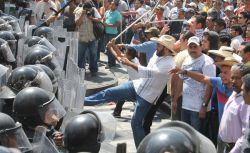 The struggle for the 43 disappeared students brought to the surface the accumulated contradictions of society. Decades of attacks on workers have undermined the social fabric of society, and exploitation, unemployment, poverty and violence are the result. The government of Peña Nieto has not solved the case of the 43 students, nor any of the ills that led to the 2014 uprising. The struggle of the masses can not remain permanently in the streets, but since nothing has been resolved, it will inevitably resurface. We must be prepared for new mass uprisings in the future. We will see radical struggles. In these elections we saw instances of open defiance against the state, and in the future we will see even fiercer battles. The bourgeoisie will not stand with folded arms, so we need greater unity of the exploited. This involves breaking the resistance of the bureaucracies within the political organizations such as Morena and the unions, which delay the necessary unity and the realization of necessary actions like the general strike.
The struggle for the 43 disappeared students brought to the surface the accumulated contradictions of society. Decades of attacks on workers have undermined the social fabric of society, and exploitation, unemployment, poverty and violence are the result. The government of Peña Nieto has not solved the case of the 43 students, nor any of the ills that led to the 2014 uprising. The struggle of the masses can not remain permanently in the streets, but since nothing has been resolved, it will inevitably resurface. We must be prepared for new mass uprisings in the future. We will see radical struggles. In these elections we saw instances of open defiance against the state, and in the future we will see even fiercer battles. The bourgeoisie will not stand with folded arms, so we need greater unity of the exploited. This involves breaking the resistance of the bureaucracies within the political organizations such as Morena and the unions, which delay the necessary unity and the realization of necessary actions like the general strike.
These elections also reflect the need for a revolutionary party of the workers, not an electioneering party but one of revolutionary struggle, which could unite and lead the various struggles. Morena arose by bringing together thousands of activists throughout the country. But unless it shifts towards a revolutionary policy, it will not be the tool that workers need. But equally, if the revolutionary party is not built, Morena will fill this gap. It can not be excluded that in the future it could be able to channel social discontent.
As events unfold we can not stand with folded arms. Conscious workers and youth must prepare for the historical tasks posed. We must educate ourselves us politically and by intervening in the living struggles and organizations of workers and youth. We need a revolutionary cadre organization linked to the youth and the working class, defending the genuine ideas of Marxism, applying them to the real and concrete conditions of our society. Capitalism is corruption, it is exploitation, misery and violence. This society offers nothing and we should not have any illusions in it. In every struggle, in every battle, we must not lose sight of our ultimate goal: radical change along socialist lines. That is, where the means of production belong to and are put at the service of society. We must put an end to this state that does not represent us and we replace it with a democratic workers' state. With a democratically planned economy, we can lay the basis for the abolition of gross economic disparities. Every human being will have access to education or work. There will be no need for violence and decay. We can make this great country a paradise to live in, and fight for the end artificial barriers of nations and the revolutionary transformation of the world.
June 8, 2015

